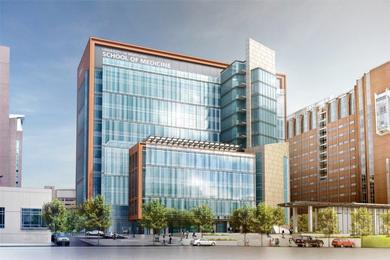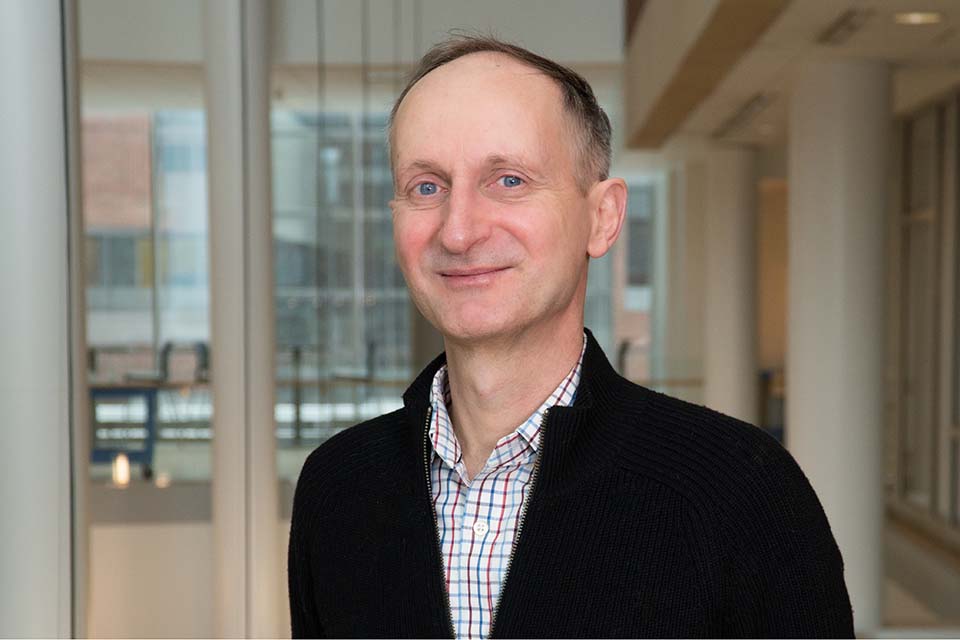University of Maryland Breaks Ground on $305.4 Million Research Building
Facility will provide laboratory space and new technology for the Schools of Medicine, Pharmacy, and Dentistry.

By Karen Robinson
September 19, 2013
On September 17, Maryland Governor Martin O’Malley and Lieutenant Governor Anthony Brown, Baltimore Mayor Stephanie Rawlings-Blake, and many other dignitaries joined Natalie D. Eddington, PhD, FAAPS, FCP, dean and professor of the University of Maryland School of Pharmacy; E. Albert Reece, MD, PhD, MBA, the John Z. and Akiko K. Bowers Distinguished Professor and dean of the University of Maryland School of Medicine; Mark Reynolds, MA, DDS, PhD, interim dean of the University of Maryland School of Dentistry; Jay A. Perman, MD, president of the University of Maryland, Baltimore; and William E. “Brit” Kirwan, PhD, chancellor of the University System of Maryland, at a groundbreaking for a 428,970-square-foot, 10-story, $305.4 million research facility.
“With this groundbreaking, we are ushering in a revolution in biomedicine, where fundamental research and advancement in technology converge to create new pathways and new opportunities for science and technology to dramatically impact the health and well-being of the citizens of Maryland, and the region, while positively impacting the economy of our state,” said Reece. “Within the portals of this building will be conducted robust collaborative research, with investigators engaging collaboratively with other colleagues across the campus and beyond.”
The new building – Health Sciences Facility III (HSF III) – will be the largest building on the UMB campus and will enable the University to retain its position as one of the leading biomedical research institutions in the world.
“This facility is an investment not just in Baltimore, but in the future of all Marylanders,” said O’Malley. “We continue to make the better choices necessary to keep Maryland on the cutting edge of science, discovery, and innovation while creating jobs. Not only will this new facility at the University of Maryland create nearly 600 permanent jobs and nearly 3,000 construction jobs, but it will also prepare generations of Marylanders for the jobs of our 21st century global innovation economy.”
“This new, multimillion dollar facility will go a long way toward cementing the city of Baltimore’s reputation as a major national center for medical innovation and discovery,” added Rawlings-Blake. “It is a valuable project that will help to boost the entire city of Baltimore and especially the people of our city’s west side. We look forward to continued collaboration with the University of Maryland, Baltimore in developing new projects to keep our city strong and flourishing.”
HSF III will be located on West Baltimore Street between the School of Pharmacy and the School of Dentistry. It will include landscaped outdoor space and a plaza for academic and social exchange among scientists, scholars, and the University community.
While primarily home to School of Medicine faculty and their research labs, the facility will also be the new location of the School of Pharmacy’s Center for Nanomedicine and Cellular Delivery, which was established in 2005 to provide expertise and foster collaborations for the design, development, and use of nanosystems for therapeutic and diagnostic purposes.
“Since its inception, the Center for Nanomedicine and Cellular Delivery has focused on fostering scientific collaborations that are dedicated to exploring and advancing the use of nanosystems in the delivery of bioactive agents for diagnosis and therapy,” says Peter Swaan, PhD, associate dean for research and graduate education at the School of Pharmacy, professor in the Department of Pharmaceutical Sciences, and director of the center. “We are very excited for this long-awaited opportunity to expand collaborations with researchers from the Schools of Medicine and Dentistry in this new, innovative space that will boast state-of-the-art technologies.”
“The School of Pharmacy is extremely pleased to see Health Sciences Facility III becoming a reality,” adds Eddington. “Research facilities like HSFIII that promote collaboration and interaction across disciplines such as medicine, pharmacy, and dentistry are the wave of the future and will help propel discoveries made in the lab to the patient’s bedside. The School of Pharmacy is fortunate to be a part of this state-of-the-art facility, and we look forward to the additional partnerships that are sure to develop from our presence in the building.”
The architecture firm working on HSF III is HOK/Design Collective Inc. The construction manager is Barton Malow Company. Construction crews will demolish the old dental school building currently occupying the site in October to make way for the new facility. The project is scheduled for completion in December 2017, with funding coming from the University of Maryland School of Medicine, which has committed to fund $65 million of the project’s total cost, as well as State Appropriations.
“The University of Maryland, Baltimore, has undertaken many projects in recent years to facilitate robust growth and development on our campus and among our schools,” said Perman. “In 1975, we occupied about 1.9 million square feet of space. In 2013, we occupy 5.9 million square feet. Every step of this expansion has enabled us to bring new jobs and millions of dollars in research and education funding to the state of Maryland. The Health Sciences Facility III further strengthens our footprint in west Baltimore and our economic impact on the city and state. We are proud to be able to help revitalize this region of Baltimore and the state of Maryland, while enabling biomedical research and education that has the potential to save lives.”
“When this facility opens, our students and research scientists will have access to the most cutting-edge of scientific facilities, as well as easier access to each other, encouraging collaboration across disciplines,” added Kirwan. “We are excited that our research scientists will be able to advance their collaborative research and discovery efforts with colleagues across the campus and the University System unimpeded by space limitations. We hope to see new, interdisciplinary partnerships develop, leading to a better understanding of human health and disease and a fully comprehensive education for our students.”

